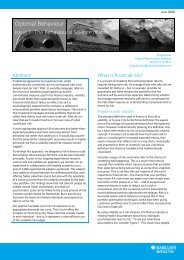COMPASS - Barclays Wealth
COMPASS - Barclays Wealth
COMPASS - Barclays Wealth
Create successful ePaper yourself
Turn your PDF publications into a flip-book with our unique Google optimized e-Paper software.
<strong>Barclays</strong> <strong>Wealth</strong> Global Research & Investments<br />
In recent years, the euro area debt crisis and regulatory changes have driven banks to<br />
diversify their sources of funding in major currencies beyond euro-denominated issues.<br />
Covered bonds have been one of the main sources of funding for financial institutions<br />
globally. Bond issuance reached a record €240bn in 2011, with the total market size now<br />
standing at just over €2.5tr (Figure 2). The market is expected to expand by an additional<br />
€88bn in 2012 across the major currencies. Although the largest part of the market is likely<br />
to remain in euros (c. 80%) some of the expansion is expected to emerge from non-euro<br />
area peripheral countries, North America and Asia-pacific.<br />
Figure 2: Gross EUR, CAD, CHF, GBP and USD covered bond issuance 1998-2012<br />
(EUR bn equivalent)<br />
bn, EUR<br />
250<br />
200<br />
150<br />
100<br />
50<br />
0<br />
105<br />
127<br />
120<br />
<strong>COMPASS</strong> March 2012 7<br />
95<br />
87<br />
131<br />
128<br />
155<br />
1998 2000 2002 2004 2006 2008 2010 2012e<br />
France Germany Netherlands Italy Other Spain Sweden UK<br />
Source: <strong>Barclays</strong> Capital<br />
Because of their liquidity, cash and short-maturity investors often consider covered<br />
bonds as effective diversification vehicles for their cash deposits and other instruments.<br />
With its established investor base, demand for covered bonds remained solid in the core<br />
developed world (Germany, France, Nordic countries, Canada and others), despite<br />
tensions in the euro area and uncertainties about the economy.<br />
…but as safe as houses?<br />
A covered bond is a debt instrument that is issued by a bank and is backed by a pool of<br />
collateral (mortgages account for 90% of the market, but some include public sector<br />
debt or a mix of both). Importantly, that collateral remains on the issuing bank’s balance<br />
sheet. Banks hold regulatory capital against the underlying loans, further reducing moral<br />
hazard since it’s in the banks’ interest to maintain the high quality of those loans.<br />
In the event of default, investors have claims on the ring-fenced asset, making the<br />
collateral pool a contingent security. Generally, the collateral sits in a separate Special<br />
Purpose Vehicle (SPV) or subsidiary, similar to securitized debt instruments where the<br />
SPV is acting as guarantors of underlying collateral, but different in that the SPV is on<br />
the bank balance sheet.<br />
Another difference with securitised mortgage-backed bonds – the source of much<br />
investment trauma in 2007-9 – is that the SPVs associated with securitised mortgages<br />
(ABS/RMBS) are completely isolated from the mortgage originator and tend to “slice and<br />
dice” or repackage into tranches different risks of the collateral pool when issuing bonds.<br />
This is not the case with covered bonds. A covered bond SPV/subsidiary does not itself<br />
issue the covered bonds, and is not isolated from the originator. The credit quality of the<br />
mortgages is actively managed and audited and has one pool rating (Figure 3). This<br />
provides transparency to the content of the cover pool and stricter governance around<br />
the content of the collateral.<br />
209<br />
184<br />
106<br />
134<br />
223<br />
245<br />
200




![PDF [0.9MB] - Barclays Wealth](https://img.yumpu.com/12809832/1/190x245/pdf-09mb-barclays-wealth.jpg?quality=85)


![PDF [0.7Mb] - Barclays Wealth](https://img.yumpu.com/12809769/1/190x245/pdf-07mb-barclays-wealth.jpg?quality=85)




![PDF [2.8 MB] - Barclays Wealth](https://img.yumpu.com/12809647/1/190x245/pdf-28-mb-barclays-wealth.jpg?quality=85)



